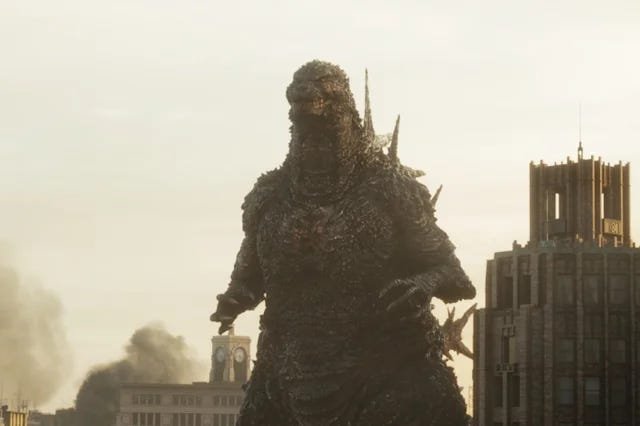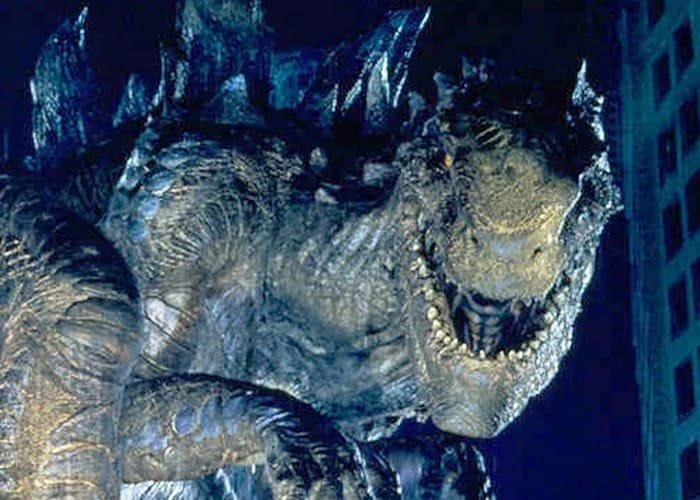Movie Review: Godzilla Minus One
I am neither a fan of Godzilla or monster movies in general. I have never understood the appeal of the entire genre - and though I had a sort of milquetoast wikipedia understanding that Godzilla was a ten story walking, roaring allegory for the nuclear bomb, I never discerned that allegory as a matter of lived in experience. Rather, Godzilla, and every kaijin and city stomping pan-dimensional monstrosity since Godzilla, were all permanently relegated in my mind to the status of D movie schlock.
Which is why, when I left Godzilla Minus One [Hereinafter “Godzilla”] emotionally drained and generally over-awed in every respect, I was a touch surprised. More than a touch, actually.
Let’s get this out of the way, Godzilla is the best new release movie I’ve seen in a very long time. I saw it, by pure chance, in black and white which, despite usually thinking black and white cuts are a stupid gimmick, in this case I know in my bones is the only way the movie ought to be watched.
Godzilla wields contrast with unbelievable deftness. And by that I mean both contrast in the purely visual sense as well as contrast in the sense of “the state of being strikingly different from something else.” The former is part of why the black and white cut is so visually stunning. The latter is used, in the broadest sense, basically every friggin’ minute of the twoish hour run time.
In fact - the notion of Contrast is so central to the movie that I think that should be the structure of this review. And so it shall be.
** WARNING - SPOILERS BELOW**
I. Narrative Contrast
I can’t think of another movie that has so successfully combined the intimate human story of a handful of individuals with the larger picture of outrageous world destroying action. I can think of some failed efforts: For instance, every monster/kaijin movie I’ve ever had the misfortune of seeing; or Steven Spielberg's War of The Worlds; or arguably Michael Bay’s Pearl Harbor.
Godzilla succeeds in this tight rope act admirably. The quadfecta of Koichi Shikishima, Noriko, Sumiko, and baby Akiko keep the film grounded in relatable human drama that serves as the movie’s emotional nerve center. These four devastated individuals, each an isolated and battered shard of the shattered vase of a burned society, together personify the unimaginable totality of War’s destruction - even as they simultaneously embody the inborn human capacity to persevere and eventually thrive in the most inhospitable circumstances - all while convincingly depicting each character’s individual emotional life and motivations.
Now smash cut in your mind’s eye to extremely compelling hi-fi depictions of uncanny valley Godzilla tearing through a cityscape and spitting nuclear explosions from his mouth left and right and you’ve got some sense of the bullet train pendulum of a narrative you’re signing up for when you see this movie.
And the thing is, the narrative works at both scales simultaneously. They totally pull it off. One second you’ll be moved to tears by Shikishima’s pained unwillingness to accept Akiko’s innocent and earnest reference to him as her “papa” and the next you’ll be overcome with thrilling excitement and swells of existential dread at mankinds capacity for self-annihilation vis-a-vis this facially ridiculous looking skyscraper sized dinosaur throwing buses around like playthings and puking hydrogen bombs left and right.
They even combine the two at certain pivotal moments - most especially when Noriko pushes Koichi behind a stone pillar a half second before the shockwave from Godzilla’s nuclear heat ray explosion sends her flying out of frame. It is a really affecting moment and is followed up by Koichi’s equally affecting visceral scream at Godzilla as an ashen rain begins to fall.
In all, the two narrative scales work - both independently and when they interact. How and why they work, I think, is not just smart and concise writing - but a result of some other contrasts…
II. Visual Contrast
Part of the reason why I think the film must be viewed in black and white is that it both simplifies the visual field and magnifies the fundamental visual campiness of Godzilla itself. I predict this has a counter intuitive effect: whereas the color in the color version makes things look more real_, _as a whole it makes the entire movie feel more fake.
Consider Godzilla itself.

The thing about Godzilla is that it looks, on its face, totally fucking stupid. Like, Godzilla is a stupid looking monster. What was, I presume, originally a function of the limitations of movement presented by the use of a man in a dinosaur costume has forever cemented the look and feel of Godzilla as, first and foremost, overwhelmingly false.
The question, I would imagine, in deciding how to depict Godzilla, is whether to lean into or away from the fundamental visual unreality of the monster itself. Take, for instance, Roland Emmerich’s shit rendition.

Emmerich’s monster is visually rationalized almost entirely, basically becoming a larger version of the T-Rex from 1993’s Jurassic Park. The result is a monster design that I have to assume absolutely no one remembers, in a movie that absolutely no one liked.1
In Godzilla, however, they went in precisely the opposite direction. Rather than attempting to make the monster ostensibly more “realistic” looking, they leaned heavily on the monster’s uncanny visual qualities. So much so that, at times, it really feels like it might be a man in a dinosaur suit.
And this decision really works. Making Godzilla feel fake is highly visually effective, to the point where every scene Godzilla is in you just can’t take your eyes off of the strangeness that is Godzilla.
But, I don’t think that effect would be as great in the color version, because color necessarily adds to object fidelity. That is to say because color is our default mode of sight, adding it to a scene necessarily brings that scene closer to our normal experience. Whereas subtracting color alienates us from normal experience.
I think this point is concisely made by comparing these two images:


In both images, there’s Godzilla in all It’s2 campy, chonky glory - but in terms of suspension of disbelief, for my money, the color image is infinitely harder to swallow. Godzilla does not belong anywhere even slightly adjacent to my visual reality - in point of fact, Godzilla, as a visual object, is orthogonal to my visual reality, and the black and white version concedes that point with grace.
However!3 By combining and contrasting: (1) realistic digital visual effects with the fundamental unrealism of Godzilla’s stilted form; (2) the normality of human settings and life with the surreal superimposition of Godzilla’s visual un-normality; (3) the intimate scale of human life with the enormous scale of Godzilla’s rampages; and then (4) setting all those dualities in the visually equalizing realm of the colorless - by doing all those things, the entire experience of Godzilla is elevated to the hyper real. That is to say, Godzilla is visually transfixing on the big screen in black and white - and no matter how absolutely batshit the set pieces become, nothing ever feels false. On the contrary, it all feels bizarrely real.
III. Audio Contrast
Naoki Sato’s score in Godzilla is extraordinary and used to incredible, equal, and opposite effect as periods of prolonged silence.
Sato’s score, when it crescendoes during the action sequences, always rides right on the cusp of being so loud and so replete with epic sound as to be both musically incomprehensible and narratively distracting. However!4 in my opinion, it rides that cusp successfully - and in so doing it evokes a sense of terrible thrill all on its own.
I can’t tell, in hindsight, whether the crescendo’s happen quickly or over time - I just know that at the peak of the action scenes the music would become so loud and so encompassing that it felt like a physical force was acting upon me - as if, had I been able to peel my eyes from the screen and look up in those moments I’d have seen the ceiling of the theater embroiled in literal storm clouds.
What’s even more astounding though is that, despite having turned the immensity dial from 10 up to 11 already, at key moments in the film Sato somehow manages to turn the whole volume up one more notch and blast out Godzilla’s classic theme while somehow _not _making it too loud. It’s a remarkable achievement - one that I suspect may not be easily recreated in the home theater setting and which all on its own begs to be viewed in a well calibrated movie theater.
Contrarily, aware that the overwhelming auditory experiences Sato’s score presented in the action sequences would require an equal and opposite force in order not to become mere noise, the choice was made in several of the intimate scenes with our lead characters to eliminate music entirely. Those bouts of silence were exactly what was called for and the content of both kind of scenes - epic action and intimate social play - were elevated as a result.
Conclusions
Godzilla is great. You should see it, ideally in black and white and in a movie theater. After viewing it, I finally understand Godzilla’s allegorical power. Godzilla is the embodied implacability and indestructibility of the unbridled force unleashed by humanity upon humanity with the dropping of the bombs on Nagasaki and Hiroshima. Watching Godzilla rampage between touching scenes of a makeshift family of strangers just trying to be alright together evoked both profound existential dread and a beautiful primordial pathos. In that sense, it is a life affirming movie that subverts its own campiness by means of its campiness and thereby elevates itself beyond camp and into the realm of art.
______________
In fact, you can go ahead and add Roland Emmerich’s Godzilla to the above list in the “Narrative” section of movies that failed to bridge the intimate and the grandiose.
I unironically do not know what Godzilla’s gender pronoun is.
3 . If the use of “However!” were to become a kind of syntactic trademark of mine, I wouldn’t mind it.
4 . Ok, I don’t like this anymore - but I’ll leave it in as an example of my own character development.